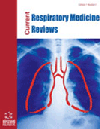-
s Treatment Failure in Ventilator Associated Pneumonia
- Source: Current Respiratory Medicine Reviews, Volume 8, Issue 3, Jun 2012, p. 239 - 244
-
- 01 Jun 2012
Abstract
Ventilator-associated pneumonia (VAP) is a severe, frequent and potentially fatal complication in the intensive care unit (ICU). Treatment failure (TF) in VAP is defined as the lack of improvement in clinical parameters and/or the persistence of the infecting microorganism, and is associated with a poor outcome. The prevalence of TF in VAP ranges from 30% to 62%, and there is general agreement that it is associated with increased mortality. TF may be related to host, bacterial, and therapeutic factors. Studies have focused on different approaches to monitor the evolution of patients with VAP, including the clinical pulmonary infection score (particularly the PaO2/FiO2 ratio), serum markers such as Creactive protein (CRP) and procalcitonin (PRC), or markers of systemic inflammatory response such as cytokines. The inappropriateness of initial antibiotic therapy is one of the main causes of clinical failure, so timely administration of appropriate antimicrobial therapy is essential. Complications of the original pneumonia and the presence of other extrapulmonary sites of infection may also be responsible for a lack of improvement in VAP and should be carefully ruled out. Rational de-escalation strategies, with or without the aid of novel biomarkers to guide the duration of antibiotic therapy, should allow for reduced antibiotic exposure. This may reduce the emergence of antibiotic resistance, related adverse events, and reduce costs without increasing the risk of TF.


